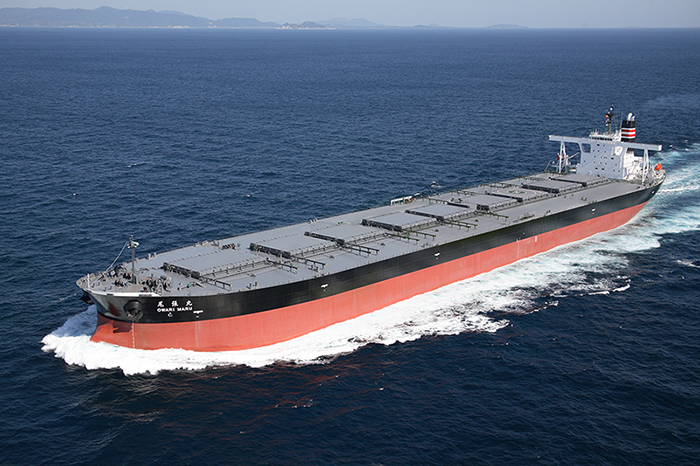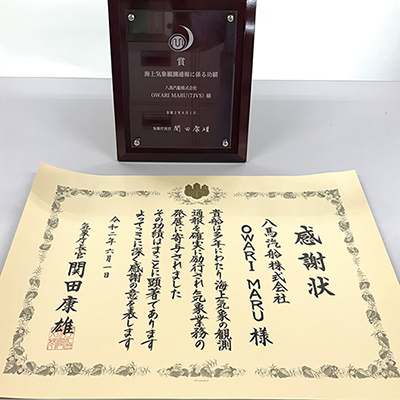NYK-operated Owari Maru, an ore carrier, was awarded the Meteorological Agency's Director-General Award on June 1 for the contribution the ship has made to meteorological business development by observing marine weather conditions and transmitting observation results over an extended period of time.
Every year, Japan’s minister of Land, Infrastructure and Transport (MLIT), together with the director-general of the Japan Meteorological Agency, commend vessels that have participated in observing and reporting marine weather conditions, and NYK-operated vessels have now been awarded the Meteorological Agency's Director-General Award for three consecutive years since 2018.
Owari Maru, which was recognized this year, has been in operation since 2007, annually transporting about 1.6 million tons of iron ore mainly from Australia to Japan.
NYK will continue to provide information on marine weather conditions to help ensure ship safety.
--Vessel Particulars
Length Overall: 319.58 meters
Breadth: 54.00 meters
Designed Draft: 18.10 meters
Gross Tonnage: 113,928 tons
Deadweight Tonnage: 229,013 tons
Ship Management: Hachiuma Steamship Co. Ltd.

Owari Maru

Plaque and letter of gratitude
- In accordance with the NYK Group’s medium-term management plan “Staying Ahead 2022 with Digitalization and Green,” the group is working to achieve the SDGs through its business activities, and this initiative contributes to the objectives and targets of the SDGs below.

- Reference
- Observation of Marine Weather Conditions
Because oceans cover 70 percent of the earth's surface, they greatly affect world weather. However, meteorological data on oceans is limited, which creates "blind spots" in the meteorological observation of the world.
Meteorological data collection by vessels sailing oceans helps compensate for the shortcomings of meteorological surveys. Not only is data collection encouraged by the UN's World Meteorological Organization (WMO), data collection is also stipulated in the International Convention for the Safety of Life at Sea (SOLAS Convention) of the UN's International Maritime Organization (IMO).
The underlying concept is that vessels navigating oceans help collect information on weather conditions in the oceans, and in exchange, oceangoing ships receive weather data from meteorological agencies around the world.
The method for ships transmitting weather data is standardized. Observation results of wind direction, atmospheric pressure and temperature, water temperature, the height of sea swells, and the types and heights of clouds, are all converted into numerical codes. This information is then distributed throughout the world via WMO's international weather-data communication network. Based on such information, meteorological agencies around the globe compile meteorological data, such as weather charts, which are then fed back to traveling vessels.
Even vessels equipped with computers and other state-of-the-art devices need to be warned of dangerous weather conditions, such as typhoons and thick fog. On the other hand, even cutting-edge weather-forecast technology using the most sophisticated computers is of little use in the absence of meteorological data for vast oceans around the globe.
It may be said, therefore, that our day-to-day life on land, not to mention the safety of oceangoing vessels, benefits immeasurably from the meteorological data that are collected through this win-win relationship between land and oceans in the observation of weather conditions.
The news on this website is as of the date announced and may change without notice.

